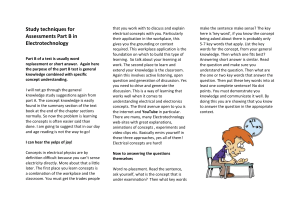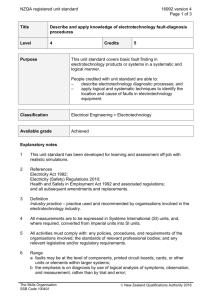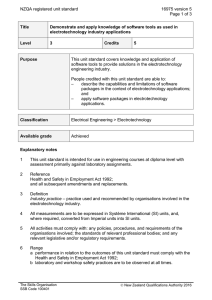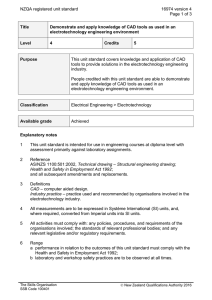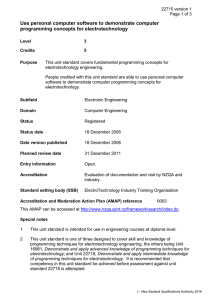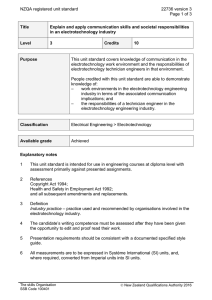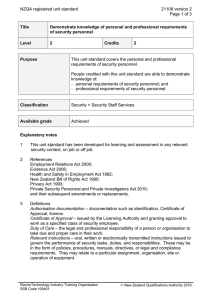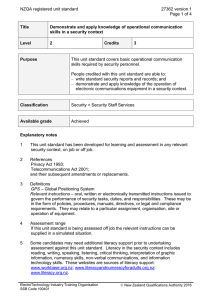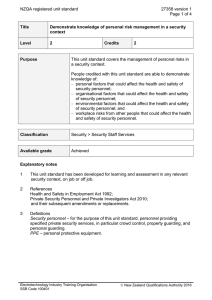NZQA registered unit standard 22738 version 3 Page 1 of 5
advertisement
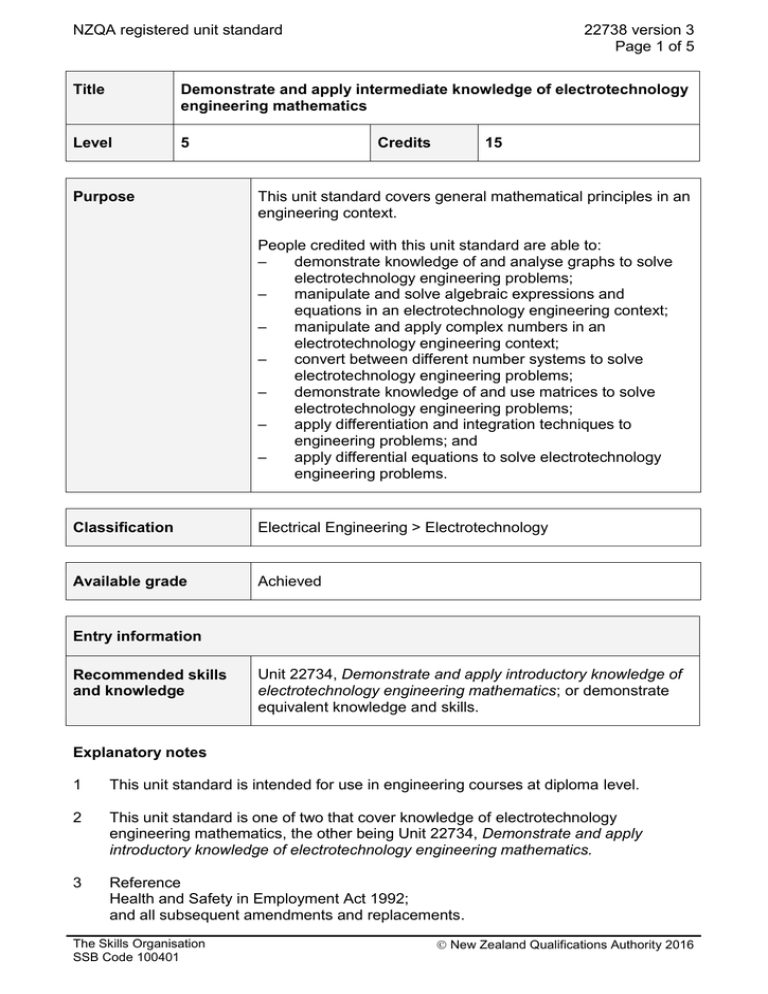
NZQA registered unit standard 22738 version 3 Page 1 of 5 Title Demonstrate and apply intermediate knowledge of electrotechnology engineering mathematics Level 5 Purpose Credits 15 This unit standard covers general mathematical principles in an engineering context. People credited with this unit standard are able to: – demonstrate knowledge of and analyse graphs to solve electrotechnology engineering problems; – manipulate and solve algebraic expressions and equations in an electrotechnology engineering context; – manipulate and apply complex numbers in an electrotechnology engineering context; – convert between different number systems to solve electrotechnology engineering problems; – demonstrate knowledge of and use matrices to solve electrotechnology engineering problems; – apply differentiation and integration techniques to engineering problems; and – apply differential equations to solve electrotechnology engineering problems. Classification Electrical Engineering > Electrotechnology Available grade Achieved Entry information Recommended skills and knowledge Unit 22734, Demonstrate and apply introductory knowledge of electrotechnology engineering mathematics; or demonstrate equivalent knowledge and skills. Explanatory notes 1 This unit standard is intended for use in engineering courses at diploma level. 2 This unit standard is one of two that cover knowledge of electrotechnology engineering mathematics, the other being Unit 22734, Demonstrate and apply introductory knowledge of electrotechnology engineering mathematics. 3 Reference Health and Safety in Employment Act 1992; and all subsequent amendments and replacements. The Skills Organisation SSB Code 100401 New Zealand Qualifications Authority 2016 NZQA registered unit standard 22738 version 3 Page 2 of 5 4 Definitions Intermediate knowledge – means employing a broad knowledge base, with substantial depth in some areas of the subject matter, to analyse and interpret a wide range of information. RMS – root mean square. 5 All measurements are to be expressed in Système International (SI) units, and, where required, converted from Imperial units into SI units. 6 All activities must comply with: any policies, procedures, and requirements of the organisations involved; the standards of relevant professional bodies; and any relevant legislative and/or regulatory requirements. 7 Range Performance in relation to the outcomes of this unit standard must comply with the Health and Safety in Employment Act 1992. Outcomes and evidence requirements Outcome 1 Demonstrate knowledge of and analyse graphs to solve electrotechnology engineering problems. Evidence requirements 1.1 Knowledge of common electrical and electronic functions and relations is demonstrated through graphs. Range 1.2 indicial, logarithmic, exponential, trigonometric. The analysis produces results that are consistent with expected outcomes. Range includes but is not limited to – trigonometric functions. Outcome 2 Manipulate and solve algebraic expressions and equations in an electrotechnology engineering context. Evidence requirements 2.1 Application of the rules for simplifying, factorising, and solving algebraic equations is demonstrated by example in an electrotechnology engineering context. The Skills Organisation SSB Code 100401 New Zealand Qualifications Authority 2016 NZQA registered unit standard 2.2 22738 version 3 Page 3 of 5 The solutions are determined by an appropriate method and are consistent with the engineering problems. Range methods include but are not limited to – simplification, factorisation. Evidence of six equations and three methods is required. Outcome 3 Manipulate and apply complex numbers in an electrotechnology engineering context. Evidence requirements 3.1 Argand diagrams are drawn and salient features identified as applied in an electrotechnology engineering context. Range 3.2 Conversion between forms of complex numbers provides results consistent with expected outcomes for two examples in accordance with industry practice. Range 3.3 real axis, imaginary axis, complex plane, complex modulus and complex argument. rectangular (Cartesian) and polar. De Moivre’s theorem is used to calculate powers and roots of complex numbers in an electrotechnology engineering context. Range integral powers and roots. Outcome 4 Convert between different number systems to solve electrotechnology engineering problems. Evidence requirements 4.1 Conversions between, and operations on, binary, hexadecimal, and decimal numbers are performed in accordance with industry practice in an electrotechnology industry context. Range up to 16 column binary and four column hexadecimal numbers. Outcome 5 Demonstrate knowledge of and use matrices to solve electrotechnology engineering problems. The Skills Organisation SSB Code 100401 New Zealand Qualifications Authority 2016 NZQA registered unit standard 22738 version 3 Page 4 of 5 Evidence requirements 5.1 Demonstration of matrix manipulation gives results consistent with expected outcomes. Range 5.2 addition, subtraction and multiplication of two dimensional matrices and vectors; simultaneous equations solved using Gaussian elimination. Knowledge of two dimensional graphic matrix transformation is demonstrated through application and examples in an electrotechnology engineering context. Range transformations, scaling, shearing, rotation, reflection, translations and combinations. Outcome 6 Apply differentiation and integration techniques to engineering problems. Evidence requirements 6.1 Differentiation is applied to engineering problems. Range 6.2 polynomials, trigonometric, exponential, logarithmic functions; product, quotient and chain rules; second derivatives, maximum and minimum. Integration is applied to engineering problems. Range polynomials, trigonometric, exponential and logarithmic functions; integration numerically using Simpson’s rule; definite and Indefinite integration; areas under curves; lengths, average and RMS values of a function. Outcome 7 Apply differential equations to solve electrotechnology engineering problems. Evidence requirements 7.1 Differential equations are derived from a textual description. Range simple first and second order equations only. 7.2 Differential equations are solved in accordance with industry practice in an electrotechnology engineering context. 7.3 Solutions are interpreted in terms of the original problem. Range The Skills Organisation SSB Code 100401 homogeneous, linear first and second order, constant coefficients; separation of variables. New Zealand Qualifications Authority 2016 NZQA registered unit standard Planned review date 22738 version 3 Page 5 of 5 31 December 2014 Status information and last date for assessment for superseded versions Process Version Date Last Date for Assessment Registration 1 18 December 2006 N/A Rollover and Revision 2 15 March 2012 N/A Revision 3 15 January 2014 N/A Consent and Moderation Requirements (CMR) reference 0003 This CMR can be accessed at http://www.nzqa.govt.nz/framework/search/index.do. Please note Providers must be granted consent to assess against standards (accredited) by NZQA, before they can report credits from assessment against unit standards or deliver courses of study leading to that assessment. Industry Training Organisations must be granted consent to assess against standards by NZQA before they can register credits from assessment against unit standards. Providers and Industry Training Organisations, which have been granted consent and which are assessing against unit standards must engage with the moderation system that applies to those standards. Requirements for consent to assess and an outline of the moderation system that applies to this standard are outlined in the Consent and Moderation Requirements (CMR). The CMR also includes useful information about special requirements for organisations wishing to develop education and training programmes, such as minimum qualifications for tutors and assessors, and special resource requirements. Comments on this unit standard Please contact The Skills Organisation reviewcomments@skills.org.nz if you wish to suggest changes to the content of this unit standard. The Skills Organisation SSB Code 100401 New Zealand Qualifications Authority 2016
